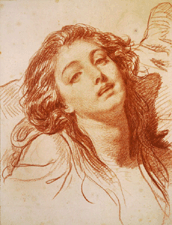She is depicted in red chalk, head lolling back, eyes glazed, lips parted. Blandly titled “Head of a Woman,” the picture was praised by the art critic Denis Diderot for being “scientifically observed,” by which he meant that the artist, Jean-Baptiste Greuze, had captured the physiological aftermath of what the French call la petite mort (“the little death”).

The year was 1765, and Greuze was 40. The woman in the drawing was said to have been his wife, Anne-Gabrielle. Madame Greuze appeared in many of her husband’s works – some as violent as this one is erotic – and their tempestuous relationship, which he fearlessly chronicled, is typical of the operatic drama that Greuze brought to his work.
The emotions are all played to the hilt: deathbed scenes, brides in tearful farewells to the family, blissful young mothers surrounded by adoring children, fathers cursing sons, and sons cursing fathers. It’s also a tour de force of drawing with works ranging from loose chalk sketches, to polished portraits to multifigure compositions.
Greuze came along at a time when erotic fantasies were fashionable when artists like Boucher and Fragonard painting boudoirs and the cavorting of gods. But the public was beginning to tire of such confections, and Greuze gave them depictions of more regular folk – not the ho-hum domestic scenes that the Dutch painted – but the big moments that come to every life.
He made a fortune turning these images into popular prints and found an intellectual champion in Diderot, the philosopher-turned-art-critic who said of him, “He draws like an angel,” and effused “That’s really my man, that Greuze.”
He later modified his embrace to take in only the art, calling Greuze “a very disagreeable character.” He was, by many accounts, hypersensitive and egotistical, the kind of artist who would immediately say of something he had done, “Look at that! Isn’t it wonderful?”
Some of his scenes can seem over the top, such as “The Torn-up Will,” in which a father leaps from his deathbed to catch his son in the act of destroying his will. The son is so startled – he’d thought the old man dead – that he dies on the spot, collapsing into the arms of his horrified wife.
Few reach such a feverish pitch. More typical is “A Marriage Contract,” a ceremony in a rustic country house, which is notable for the subtle and conflicting emotions that Greuze is able to coax out of the participants, from the good-hearted parents stricken at their daughter’s imminent departure, to the envious glare of the older sister, to the complex play of feeling in the face of the bride. Those emotions are amplified in a preparatory study of her face, known as “Greuze’s Mona Lisa,” in which you can read both sadness and repressed excitement in her downcast eyes and soft smile.
In his later years, Greuze’s domestic themes became darker and more violent. He didn’t have to look far for inspiration. His wife was a woman of unpredictable impulses and fits of fury. She was so promiscuous that a Greuze painting of her as one of the Vestal Virgins prompted Diderot to remark “That one, a Vestal Virgin! … you are pulling our leg.”
When divorce was legalized in 1793, Greuze was one of the first in line. The pen-and-ink drawing “The Angry Wife” parallels an event he described in his divorce petition in which a wife rushes at her husband with a cooking pot. In real life, she came at him with a more odious chamber pot.
Greuze’s willingness to publicize such personal material suggests a rare frankness —or perhaps just a complete immersion in his art. Whatever embarrassment it cost him in real life was secondary to giving life to pictures that have no parallel elsewhere in art.
The Frick Museum
2002

